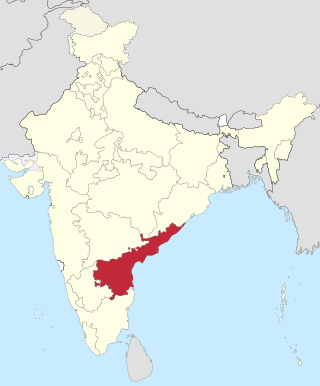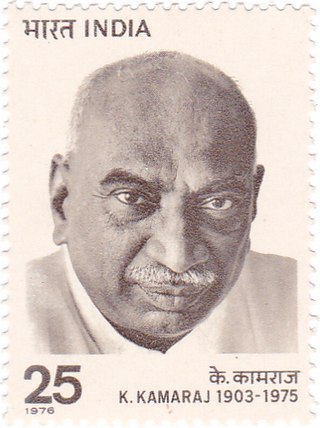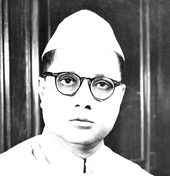Elections in India in 1955
 |
|---|
National coalitions |
 |
|---|
Legislative Assembly elections in India were conducted for Andhra State Legislative Assembly in 1955. In Andhra State, Indian National Congress won an absolute majority. [1]
 | |||||||
|---|---|---|---|---|---|---|---|
| Parties and Coalitions | Popular vote | Seats | |||||
| Vote | % | +/- | Contested | Won | +/- | ||
| Indian National Congress | 33,94,109 | 39.35% | 142 | 119 | |||
| Krishikar Lok Party | 6,25,827 | 7.26% | 37 | 22 | |||
| Communist Party of India | 26,85,251 | 31.13% | 169 | 15 | |||
| Praja Socialist Party | 4,81,666 | 5.58% | 45 | 13 | |||
| Praja Party | 2,40,884 | 2.79% | 12 | 5 | |||
| Independents | 11,88,887 | 13.78% | 170 | 22 | |||
| Source: Election Commission of India [2] | |||||||
* : On 1 October 1953, a separate Andhra State, consisting of the Telugu-speaking areas of the composite Madras State, with 167 constituencies with 190 seats in the Assembly, was formed. On 1 November 1956, Andhra State was merged with Hyderabad State under States Reorganisation Act, 1956, to form a single state, Andhra Pradesh. The districts of Raichur, Gulbarga and the Marathwada district were detached from the Hyderabad State, while merging with Andhra State. In addition, the Siruguppa taluk, the Bellary taluk, the Hospet taluk and a small area of the Mallapuram sub-taluk were transferred from Mysore State to Andhra Pradesh. The districts of Raichur and Gulbarga were transferred to the Mysore State, while the Marathwada district was transferred to the Bombay State. [3] This resulted in re-organization of assembly constituencies of Andhra Pradesh giving way to 85 constituencies with 105 seats in the assembly.
This article is about the first election held in Independent India in 1955

Andhra State was a state in India created in 1953 from the Telugu-speaking northern districts of Madras State. The state was made up of this two distinct cultural regions – Rayalaseema and Coastal Andhra. Andhra State did not include all Telugu-speaking areas, as it excluded some in Hyderabad State. Under the State Reorganisation Act of 1956, Andhra State was merged with the Telugu-speaking regions of Hyderabad State to form Andhra Pradesh.
The States Reorganisation Commission (SRC) constituted by the Central Government of India in December 1953 to recommend the reorganization of state boundaries. In September 1955, after two years of study, the Commission, comprising Justice Fazal Ali, K. M. Panikkar and H. N. Kunzru, submitted its report. The commission's recommendations were accepted with some modifications and implemented in the States Reorganisation Act in November, 1956. The act provided that India's state boundaries should be reorganised to form 14 states and 6 centrally administered territories.

The first legislative assembly Election to the Madras state based on universal adult suffrage was held in March 1952. This was the first election held in Madras state after the Indian Independence. This election was officially known as the 1951 Madras State Election, even though through delays, actual voting didn't take place until early 1952.

The second legislative assembly election to the Madras state was held on 31 March 1957. This was the first election held after the linguistic reorganization of Madras state in 1954. Indian National Congress and its leader K. Kamaraj won the election, and defeated its rival Dravida Munnetra Kazhagam. In 1954, due to the resignation of C. Rajagopalachari, for his controversial Kula Kalvi Thittam, the leadership of Congress was contested, between K. Kamaraj, and C. Subramaniam. Eventually, K. Kamaraj, won the support of the party, was elected leader and chief minister of Madras State in 1954. In a surprise move, he appointed both M. Bhaktavatsalam and C. Subramaniam, in his cabinet, allowing great unity amongst Congress, that ruled the state of Madras, for the next decade. This election saw future DMK leaders, M. Karunanidhi and K. Anbazhagan winning their first MLA seat in the legislative assembly.

The States Reorganisation Act, 1956 was a major reform of the boundaries of India's states and territories, organising them along linguistic lines.

Elections to the Legislative Assembly of the Indian state of Hyderabad were held and Sri Burgula Rama Krishna Rao took oath as First Chief Minister of Hyderabad State on 6 March 1952. 564 candidates competed for the 175 seats in the Assembly. There were 33 two-member constituencies and 109 constituencies single-member constituencies.

Elections to the Legislative Assembly of the Indian state of Bombay were held on 26 March 1952. 1239 candidates contested for the 268 constituencies in the Assembly. There were 1 three-member, 47 two-member constituencies and 220 single-member constituencies.

Elections to the Legislative Assembly of the Indian state of Mysore were held on 26 March 1952. 394 candidates contested for 99 seats in 80 constituencies in the Assembly. There were 19 two-member constituencies and 61 single-member constituencies, accounting for 99 seats.

Elections to the Rajasthan Legislative Assembly were held on 29 February 1952. 616 candidates contested for the 140 constituencies in the Assembly. There were 20 two-member constituencies and 120 single-member constituencies.
Elections to the Andhra State Legislative Assembly were held on 11 February 1955. 581 candidates contested for the 167 constituencies in the Assembly. There were 29 two-member constituencies and 138 single-member constituencies. The members of the first assembly (1955–62) were allowed a seven-year term. That is to say in 1957, elections were conducted in the newly added region of Telangana alone and then in 1962 general elections were held for the state as a whole.
Elections to the United Andhra Pradesh Legislative Assembly were held on 25 February 1957. 319 candidates contested for the 85 constituencies in the Assembly. There were 20 two-member constituencies and 65 single-member constituencies. The members of the first assembly (1955–62) who were elected from the 1955 election were allowed a seven-year term. That is to say in 1957, elections were conducted in the newly added region of Telangana alone and then in 1962 general elections were held for the state as a whole.
Elections to the Bombay Legislative Assembly were held on 25 February 1957. 1146 candidates contested for the 339 constituencies in the Assembly. There were 57 two-member constituencies and 282 single-member constituencies.

Elections to the Mysore Legislative Assembly were held on 25 February 1957. 589 candidates contested for the 208 seats of the 179 constituencies in the Assembly.
Kustagi Lok Sabha constituency is a former Lok Sabha constituency in Hyderabad State, India. This seat came into existence in 1951. With the implementation of States Reorganisation Act, 1956, it ceased to exist.
Yadgir Lok Sabha constituency was a former Lok Sabha constituency in Hyderabad State. This seat came into existence in 1951. With the implementation of States Reorganisation Act, 1956, it ceased to exist.

Andhra Pradesh, retrospectively referred to as United Andhra Pradesh,Undivided Andhra Pradesh or Ummadi Andhra Pradesh, was a state in India formed by States Reorganisation Act, 1956 with Hyderabad as its capital and was reorganised by Andhra Pradesh Reorganisation Act, 2014. The state was made up of three distinct cultural regions of Telangana, Rayalaseema, and Coastal Andhra. Telangana was part of Hyderabad State formerly ruled by Nizam of Hyderabad, whereas Rayalaseema and Coastal Andhra were part of Andhra State which was formerly a part of Madras Presidency ruled by British India.
Cumbum was one of the 294 Legislative Assembly constituencies of Andhra Pradesh state in India. It was in Prakasam district and was dissolved before the 2009 elections and most of its area is now in Giddalur.